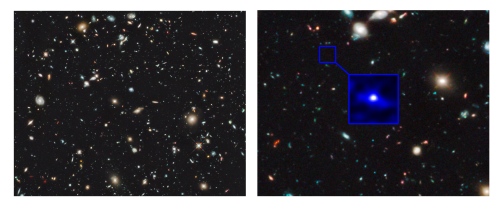The Hubble Space Telescope may have discovered the farthest-away object ever identified, a galaxy with light that began shining when the universe was only about 500 million years old.
The galaxy was born at a time of rapid acceleration in the birth rate of stars, according to the study released today by the journal Nature. The observation needs to be confirmed with spectroscopy, an analysis of light that shows the temperature, mass, luminosity and composition of an object.

The Big Bang that scientists believe began the universe occurred an estimated 13.7 billion years ago. Another early galaxy, created about 600 million years after the universe was formed, was discovered in October, also identified using Hubble. Finding early space objects created immediately following the Big Bang can provide clues as to how the universe was formed.
“This is clearly an era when galaxies were evolving very rapidly,” wrote the authors, led by Rychard Bouwens, an astronomer at the University of California, Santa Cruz.
The Hubble, run by NASA, is a space-based telescope that was carried into orbit by a space shuttle in 1990, according to the National Aeronautics and Space Administration website. Astronauts repaired and upgraded the school-bus-sized Hubble in 2009 to extend its life.
Deep Field
Today’s data come from a small area of the sky known as the Hubble Ultra Deep Field, which were detected using the Wide Field Camera 3. This upgrade, installed in 2009, has the potential to be 35 times better at infrared than the Advanced Camera for Surveys, installed at the telescope in March 2002.
Confirmation from the James Webb Space Telescope is needed to ascertain this object is a galaxy. That telescope is scheduled to be launched in 2014 to replace the Hubble and see deeper into the universe’s past.
Finding far-away galaxies is difficult because their once- bright light falls into the infrared part of the spectrum, which isn’t visible to the naked eye.
After the Big Bang, the universe expanded and cooled, losing enough heat so that protons and electrons combined to form hydrogen, a relatively opaque gas which consists of a single proton orbited by a single electron. At some point, some electrons split off, ionizing the hydrogen and making it relatively clear, allowing people on earth to gaze at the stars.
(Bloomberg)
<한글 요약>
가장 오래된 은하계 발견
허블 망원경으로 가장 먼 거리의 은하계를 볼 수 있었다고 미 항공우주국에서 밝혔다. 이 은하계는 우주 생성 초기때부터 빛나고 있었던 은하계로 우주가 만들어진 지 5억년 밖에 되지 않았을 때부터 빛나고 있었다고 한다.
이 결과는 과학 저널 네이처에도 공개가 되었으며, 이번 관찰은 빛을 분석하고 그것의 온도, 질량, 발광정도 등을 알아내는 분광기에 의해서 확인될 필요가 있다고 한다.
과학자들이 우주의 시초라고 믿는 빅뱅은 137억년 전에 시작되었는데 우주가 형성된 후 6억년후에 만들어진 이 은하계는 작년 10월 허블망원경으로 인해 발견되었다.
우주 형성 초기에 있었던 물체의 발견은 우주가 어떻게 형성되었는지에 대한 단서를 제공할 수 있다는 점에서 이번 발견은 의미가 있다고 한다.
가장 오래된 은하계 발견
허블 망원경으로 가장 먼 거리의 은하계를 볼 수 있었다고 미 항공우주국에서 밝혔다. 이 은하계는 우주 생성 초기때부터 빛나고 있었던 은하계로 우주가 만들어진 지 5억년 밖에 되지 않았을 때부터 빛나고 있었다고 한다.
이 결과는 과학 저널 네이처에도 공개가 되었으며, 이번 관찰은 빛을 분석하고 그것의 온도, 질량, 발광정도 등을 알아내는 분광기에 의해서 확인될 필요가 있다고 한다.
과학자들이 우주의 시초라고 믿는 빅뱅은 137억년 전에 시작되었는데 우주가 형성된 후 6억년후에 만들어진 이 은하계는 작년 10월 허블망원경으로 인해 발견되었다.
우주 형성 초기에 있었던 물체의 발견은 우주가 어떻게 형성되었는지에 대한 단서를 제공할 수 있다는 점에서 이번 발견은 의미가 있다고 한다.








![[Graphic News] More Koreans say they plan long-distance trips this year](http://res.heraldm.com/phpwas/restmb_idxmake.php?idx=644&simg=/content/image/2024/04/17/20240417050828_0.gif&u=)
![[KH Explains] Hyundai's full hybrid edge to pay off amid slow transition to pure EVs](http://res.heraldm.com/phpwas/restmb_idxmake.php?idx=644&simg=/content/image/2024/04/18/20240418050645_0.jpg&u=20240419100350)







![[KH Explains] Hyundai's full hybrid edge to pay off amid slow transition to pure EVs](http://res.heraldm.com/phpwas/restmb_idxmake.php?idx=652&simg=/content/image/2024/04/18/20240418050645_0.jpg&u=20240419100350)

![[Today’s K-pop] Illit drops debut single remix](http://res.heraldm.com/phpwas/restmb_idxmake.php?idx=642&simg=/content/image/2024/04/19/20240419050612_0.jpg&u=)